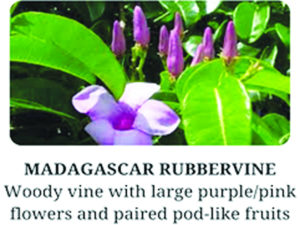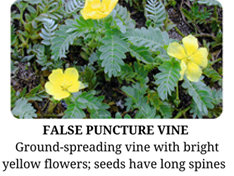



 Over the last few weeks, you may have seen an ad or heard about invasive plant management in Anguilla, and if you did, you may be wondering: what are invasive plants? What do we mean by management? And why on earth should you care?
Over the last few weeks, you may have seen an ad or heard about invasive plant management in Anguilla, and if you did, you may be wondering: what are invasive plants? What do we mean by management? And why on earth should you care?
Invasive plants are plants that are not native to Anguilla, meaning they were introduced whether intentionally or accidentally, and will (or have already) spread out of control and cause harm to the natural environment. You may already be familiar with some invasive animals, like the vervet monkey, giant african snail, or green iguana; well just like these, invasive plants have similar negative impacts on native biodiversity, the economy, and human health. They can outcompete native species and take over natural habitats, especially vines like the rubber vines and jasmine. Vines also cause damage to infrastructure like power lines and poles, with high economic costs to fix these damages.
Some invasive plants can be poisonous to livestock, like the false puncture vine, or have a tendency to overgrow pastures and reduce grazing area, like yerba porosa, both of which can negatively affect farmers and reduce Anguilla’s food security. Human health can also be at risk from invasive plants, with some being harmful to the touch, like the tropical bull nettle that has both stinging hairs and toxic latex that can cause serious skin irritation. So it is clear that invasive plants can be dangerous and are worth managing.
To do so, the Department of Natural Resources – Environment Unit is currently implementing an Invasive Plant Management Project, with funding from Darwin Plus, and additional support from the Great Britain Non-native Species Secretariat and Durham University. The project is titled “Protecting Anguilla’s biodiversity by building capacity in invasive plant management”, and as the name suggests, we are focused not just on managing invasive plants in the country, but also building local capacity to reduce the risk of introducing and spreading invasive plant species.
During a prioritization workshop in Anguilla in February 2020, a group of local stakeholders identified several invasive plants for management. For this specific project, there are five (5) identified priority species of invasive plants: “(Brazilian jasmine (Jasminum fluminenese), False puncture vine (Tribulus cistoides), Madagascar rubber vine (Cryptostegia madagascariensis), Tropical bull nettle (Cnidoscolus urens) and Yerba porosa (Porophyllum ruderale). These invasive plant species are located throughout Anguilla. In an effort to determine the extent of their distribution, monitoring and management protocols are required to help reduce the spread. And this is where you – the public – can get involved. Invasive plants in the environment can affect us all, and we all need to work together to manage them. Throughout this project, we will be working along with you to:
• locate and map invasive plants across Anguilla
• keep track of their populations
• prevent them from spreading to new places
• volunteer or participate in control actions
• prevent the introduction of new invasive plants to the country
in light of the aforementioned, The Department of Natural Resources-Environment Unit hosted an Invasive Plant Awareness Week program from 26 – 30 June, 2023 under the theme “Let us stop the spread of invasive plants in Anguilla”. The Awareness Week was a key component of the Communication and Public Awareness Plan for the project. A series of activities were completed including a virtual launch, radio interviews, Facebook Trivia, Poster Distribution and an exhibition. The radio interviews and the exhibition were promoted live on radio and on Facebook. The week of activities culminated with the Awareness Week Exhibition held at the People’s Market from 10:00 am-4:00 pm on Friday 30th 2023. Approximately 200 persons participated in the exhibition.
We also presented at the Council of OECS Ministers of Environmental Sustainability (COMES) 10 Exhibition, from July 11th to 13th, with an impressive suite of other booths displaying projects tackling environmental issues across Anguilla. This exhibition was open to the public and also hosted the delegation of OECS Ministers on the evening of July 11th. A total of about 130 persons visited throughout the three days of exhibition, ranging in age and experience from summer camp participants at the library to seasoned environmental Ministers.
The Invasive Plant Project team would like to thank everyone who engaged with us – whether via Facebook, over the radio, or in-person at the exhibitions – and we look forward to your continued support and collaboration as we continue to work together to facilitate more educational and awareness activities on invasive plant management throughout the island.
Let’s stop the spread of invasive plants in Anguilla!
For more information, contact: Facebook: Anguilla Invasive Plant Management Project Phone: 264-497-0217 Email: anguilla.dplus125@gmail.com








